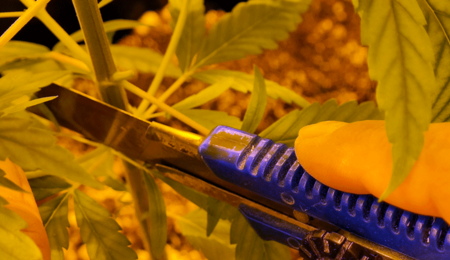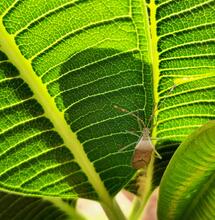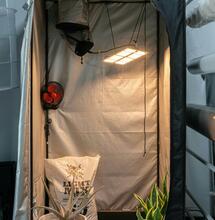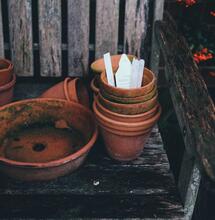The Art of Pinching and Pruning Plants

Many people often ask me about the ways I pinch and prune my plants. They ask if and when it is appropriate to do so, and also how it should be done. The following article will give you answers to all these questions.
What is pinching
Pinching means removing new shoots on the main stalk or side branches. Its goal is either to prevent development of a new shoot, usually done by pinching of lateral shoots, or slowing down the vertical growth of plants and boosting development of lower shoots which can be done by pinching the main terminal or the tops of side branches. Cannabis plants, similarly to certain kinds of trees, grow in the cone shape. The main stalk grows straight up and the side branches are the longest in the lower parts of the plant. This way, the plant ensures the best access to sunlight for all parts. However, it can always adjust its shape according to current natural conditions. For instance, if you sow plants close to one another, the development of the side branches will be suppressed, or they will try to grow along the main stem up in order to reach the light. In any case, the main terminal of the cannabis plant always grows primarily in height – which may be inconvenient for some growers and that is why they decide to employ the pinching technique.
Why you should pinch
If you grow outdoors, it is usually not necessary to pinch your plants. They can evolve to an optimal shape naturally. Moreover, the height of plants is not usually much of a problem while growing outdoors. However, while growing under artificial light, growers need to limit the height of their plants almost in every case, mainly for two reasons. The first one is limited space in the growing room. For example, if your room has two meters in height, you cannot grow two meter tall plants. There have to be at least 30 centimeters of space between the plant and the light source but usually you need even more. Second, you have to limit the height of plants when growing indoors because of the effective power of the light source.
To use its performance effectively, all plants should be located within the same distance from the light. That is because the performance of the light source decreases dramatically with the increasing distance – the tops of plants usually receive tens percent more light than the branches located lower. Such a drop doesn’t occur when growing outdoors. To summarize: pinching is useful for limiting the height of your plants as well as for the regulation or increase of lateral shoots.
How to pinch
There are two basic techniques of pinching. The most common is the removal of the whole sprouting shoot. If you pinch the whole growing shoot at the top of the main terminal, two new lateral shoots start developing under it quite quickly. The same happens when you remove the top of any other side branches – the two closest shoots to it start developing quickly. In this way, you can increase the number of the tops of the terminal or lateral branches. You can repeat this process several times if you want to. You only need to let the branch grow at least two sets of leaves and you can pinch the top of the branch again. The two lateral shoots below always speed up their growth. However, you should not pinch the branches too much if you grow plants with the intention of harvesting buds. If you want your plants to grow nice big buds, it’s good to keep the number of branches between one and eight.
Nevertheless, you can use extensive pinching when you produce clones, because with them, you want to have as many shoots on the mother plant as possible. Pinching can be further used to eliminate the growth of the lateral branches. In such case, you pinch the shoot right at the main stem or branch as you can see in one of the pictures. Another pinching method is called FIM by growers. With this method, you pinch the cluster of new shoots at the main terminal about a half higher than with the classic pinching method. The top of the flower does not consist of a single sprout but three to five of them.
When you manage to pinch this part in the right way using the FIM method, you get four to five new branches on the top of the plant – these can later yield nice buds. This technique is especially useful in small growing spaces where you want to have as much buds as possible (for example in micro growing). On the contrary, it is not so useful for the so-called sea of green technique when the plants are very close to each other. If you want to regulate the height of plants while growing outdoors or in a greenhouse, pinch the main terminal using the classic method and try to point the lateral branches as much to the sides as possible. The more sunlight they receive, the shorter they will be.
When and how to pinch
You should pinch the plants in the growth stage before they start forming flowers. They should have at least three sets of leaves before you start pinching them. Also make sure the branch has at least three shoots. At the latest, pinching is recommended when switching to the flowering stage. Really, some people pinch the plants as late as the day when they switch to the flowering stage, however, according to my own experience, it is best to pinch them seven to five days before the transition – at the latest. You should always use clean scissors or a sharp knife for pinching. The cut should be straight in order to make the wound on the plant as small as possible. The FIM method, though, should be done using fingers – you can pinch the sprouts using simply your thumb and index finger.
When not to pinch
You should never pinch auto-flowering strains. Any damage done to plant’s tissue causes stress and slows down its growth for several days. Auto-flowering strains have a relatively short life cycle and thus every slowdown in their development is counterproductive. It is best to leave them grow naturally, without any interventions. With non auto-flowering strains, it is not recommended to pinch the plants during the flowering stage. In this stage, it is much better to prune them.
What is pruning and why it’s worth doing
When the plants are already bigger, and you do not like their shape, you can prune them according to your needs. Pruning means removing larger parts of plants. Choose whole branches, for example, which wouldn’t receive enough light, or are in your way. They would only absorb energy which would be otherwise used by the rest of your plant. In indoor growing, the more branches plants have, the more buds they form, but such buds would be smaller.
That is why it is sometimes advisable to limit the number of branches (ideally to already mentioned four to eight branches) to boost the growth of dense buds. Of course, buds too large can be disadvantageous as well – they are too heavy for weak branches and need to be supported. But let’s be honest, who would prefer small buds over large ones...
Pruning further involves removing lower branches that do not receive enough light because they cannot get reach high enough to make contact with the light source. When you remove them, the plant can use more energy for the growth of more promising branches. Moreover, if you employ the sea of green or green wall techniques, removing lower branches can improve the airflow between the plants, thus preventing mildew.
How and when to prune
Pruning is a something that needs to be properly thought over. It is best to prune during first two to three weeks of the flowering stage. In this period, you can already see which parts of plants have a good chance to receive plenty of light and which are weak and useless. You only want to keep such branches that can yield substantial buds. During these two weeks, we can cut the branches between one to three times. It is best to remove entire branches about one centimeter from the stem. As with pinching, one should use a sharp clean knife or scissors and try to make the wound as small as possible.
Although I have already warned you that pruning should not be done in the flowering stage, there is one exception – we can remove shoots on branches that grow in places without a good access to light. You can find such shoots in the lower parts of otherwise promising branches. In fact, these outgrowths are already future flowers.
Without enough light, though, they would be too weak and would only draw energy from the rest of the plant. Thus, the majority of the experienced growers always remove the lower branches. Before pruning, take look at the whole plant and choose the branches that you want to keep. Try to remove any branches that would cross or shade each other – this applies to all your plants so mind the neighboring ones as well. Your goal is to achieve an optimal number of branches where all the potential flowers will get enough light. Moreover, the growing space should be well ventilated as well.
When not to prune
As with pinching, pruning shouldn’t be done on auto-flowering strains. The only exception is when you find low branches that are stunted and do not grow. Bear in mind that you should remove them before the plant switches into the flowering stage. You should never prune any strains after third week of flowering.
Removing leaves
Removing leaves is another often discussed topic, especially with the indoor growing, because outdoor it doesn’t make much sense. The large leaves often overshadow flowers and if they are overlapping, then water condensates on them and the risk of mildew increases. No wonder many growers want to limit the number of leaves on their plants. Fortunately, cannabis plants grow more leaves than they need. Removing leaves should be done in the same period as pruning.
You should always remove only the large leaves growing on the parts of the plant without flowers. Mind that the plant needs leaves for its development – it uses them to absorb the energy from the source of slight, which is an essential part of photosynthesis. When you finish removing leaves, you should still not be able to see through the plant when viewed from above. If you are pruning leaves for the first time, the golden rule applies is “less is more”.
If some leaves seem to be in the way during the final period of the growing cycle, remove only those that are extensively overshadowing your plant and are covered with water as a reason of their overlapping. If you remove too many leaves during the flowering stage, it boosts the growth of tiny leaves in flowers – and this only complicates the harvest. By Mr Jose, info@pestovat.cz



.png)